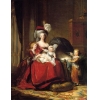|
 As in any area
of life where art is applied, fashion interacts with the society and is
affected by the changes adopted in it. Fashion, on the whole, reveals the most historical
epochs and events. Thus, the XVII century introduced the pretentiousness of
royal ensembles from the opulent silk with embroidery and the simplicity of the
Puritan attire at the same time. As in any area
of life where art is applied, fashion interacts with the society and is
affected by the changes adopted in it. Fashion, on the whole, reveals the most historical
epochs and events. Thus, the XVII century introduced the pretentiousness of
royal ensembles from the opulent silk with embroidery and the simplicity of the
Puritan attire at the same time.
The entire century
was famous for the drastic change of fashion tendencies, as never in the
history. The fashion of early XVII century dictated too fluffy gowns with high
collar in many layers, high waistline and extremely puffed sleeves. The second half
of the century the fashion undergone sea changes and wide gowns with higher
waistline were replaced by slimmer upright silhouettes with the horizontal
accent onto the shoulder line.
Wide and
puffed sleeves that end at the elbow line or a bit lower became narrower and
longer. In the second half of the XVII century
a girdle found the way to hearts of ladies which was a perfect tool to support
the breast alluringly making it look higher and bigger and the waist- slimmer.
In the end of the century a more fetching and seductive trend was set when the
upper skirts were slightly rose revealing the petticoat usually embroidered and
decorated with some details to enjoy.
In the end
of the XVII century a new garment was introduced to find its niche for ever
times, that is fur coat offered as the loose mantel letting down the shoulders
to the floor. This caper was the nice substitute of traditional match of fluffy
skirt and the tightly-fitted bodice. The new look was far more modest and reserved
than the dresses with too open low neck and girdles. However, the new attire was
also decorated with bows, bands and ruches.
Another innovation
was introduced in the late XVII century. Since ladies of the high society in France and in England never yielded to men, going
together with them to hunt or ride, the fashion designers created special
attire for riding for them. Such ensembles were consisted of the special
comfortable coats which resembled men’s coats to wear over the long petticoat to
the ankle line. Those who criticized such innovations stated that the only
thing to differ between men and women was the long skirt.
The early
XVII century was known for the most fashionable fabric adopted at the royal
courts and high society – the silk with the elegant floral embroidery. That period
of the epoch was flourishing and favorable for the finest lace and all the
attire for men and women were decorated with laced details. The liking for the
floral motifs was not long-term, though and in 20s of the XVII century the
lavish single-color satin replaced the laces, and the embroidery was
substituted by bows and ribbons.
More modest
and temperate types of fabric were used beyond the royal court and high society
salons and women mainly wore clothes made from dyed flax or wool.
The XVII century
was famous for the civil war in Great
Britain and occurrence of new religious
trends which were then demonstrated in fashion. In the early XVII century the
royal court followed the delicate and lavish French style and a little bit
later, with the flourishing or Puritanism, more temperate attires of darker
shades were in.
The Protestant
and Catholic churches both undertook the attempts to reduce the eccentricity of
attires the high society accustomed to making it look plain. So, in the early '30s of the XVII century Louis XIII, the
Queen of France, issued two acts of law forbidding clothes with laces and lavish
embroidery for everyone apart from the noble persons. Also the use of ruches
and bows was restricted to zero.
The Puritan
church followers introduced the unpretentious dark colors into the fashion
along with the mild cut. Yet, the cheering low neck was replaced by modest
dresses with a higher collar and hats to cover the hair. Both men and women avoided
clothes of vivid colors, glittering fabric and plenty of accessories.
The most trendy
colors favored by puritanical and Genevan ladies included dark-brown,
brown-to-red and dark-green. The black dresses were kept for special cases
since the black dye was extremely expensive and quickly faded. There was nothing
left from the complimentary silk and satin loved by French and English
aristocrats in the clothes of Puritans. The most demanded fabric was wool and flax,
and dresses were seldom trimmed with lace.
|